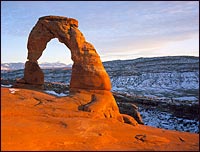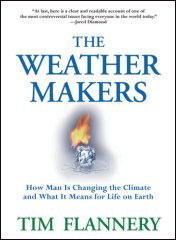Here at Grist, we tend to be good at detecting extremely subtle patterns. Like, say, the way certain politicians keep trying to drill in certain areas. Or the way love letters inevitably come after we publish a striking photo that might portray Umbra Fisk. Or the number of rainy days in a row outside our Seattle office.
Lately, we’ve noticed a whole mess of books emerging about climate change. If the whims of publishers are any indication, this climate thing might just be real. We hereby review a few of the shiniest tomes coming out this spring — and if our keen insights on other matters are any indication, this won’t be the last of them. Stay tuned.
Weather or Not
Australian scientist Tim Flannery is on a mission. His new book The Weather Makers: How Man Is Changing the Climate and What It Means For Life on Earth, published in his home country this past fall, appears to have softened his government’s long-standing skepticism about climate change. “If it has a similar effect in the U.S., I’ll die a happy man,” Flannery recently told an interviewer.
The renowned mammalogist and conservationist is a fine writer — he is the author of The Future Eaters and The Eternal Frontier, among many other popular-science books. The Weather Makers, released in the U.S. this month, translates and summarizes an enormous swath of climate research, covering dozens of disciplines and centuries of painstaking work. Flannery throws in enough asides and anecdotes to keep the science lively, but doesn’t skimp on the meaty details: If you want to know why the zooxanthellae of the world are suffering, or what the acronym TRIFFID has to do with the forests of the future, this is the book for you.
Flannery opens with a primer on the general workings of the atmosphere — “the great aerial ocean,” in the words of Alfred Russel Wallace — and the intricacies of the greenhouse effect, including a close look at when and how humanity started heating up the planet. He follows this introduction with an efficient tour of the thawing poles, the dying corals of the Great Barrier Reef, the cloud-deprived cloud forests of Costa Rica, and the world’s expanding deserts. He then describes the science of climate modeling — a fearsome topic for any popular-science writer — and expertly navigates a sea of acronyms, technicalities, and frightening forecasts.
In his final chapters, Flannery sums up the solutions available to humanity. “If everyone who has the means to do so takes concerted action to rid atmospheric carbon emissions from their lives, I believe we can stabilize and then save the cryosphere,” he writes. “We could save around nine out of every ten species currently under threat, [and] limit the extent of extreme weather events so that losses of both human life and investments are a fraction of those being predicted.” To accomplish this, he calls for a “linked lifeline to climate safety,” with individual purchases of renewable energy by affluent consumers driving down overall costs, in turn making clean power affordable to the developing world. Only with the sustained effort of individuals and governments, he says, can we avoid what he calls “the full carbon catastrophe.”
Flannery intends The Weather Makers to be a “manual on the use of the Earth’s thermostat,” and it is an extremely knowledgeable — and sobering — overview of our disruption of the global climate. Yet the view he provides is a somewhat distant one. Because of his broad scope, he skims across oceans and continents at breakneck speed, pausing for only a few descriptive paragraphs in any one place.
Perhaps the thing to do is to read The Weather Makers, then get up off the couch and take a long walk outside. Global warming means something different for each of us, something very particular to our lives and our places, and it’s worthwhile to ponder those varied implications. The more clearly we envision our own future, the more easily we can share Flannery’s well-founded sense of urgency.
— Michelle Nijhuis is a freelance writer in Paonia, Colo., and the winner of the 2006 Walter Sullivan Award for Excellence in Science Journalism.
Not So Great Moments in Global Warming
Scientists, Eugene Linden writes, have long been “blasé about the possibility of a catastrophic breakup of Greenland’s ice sheet.” No more. Recent satellite imagery shows the glaciers are melting twice as fast as previously believed. Along with coral reefs, ocean currents, tree rings, and ice-core data, the melting glaciers seem to offer a clear conclusion: global warming is under way, and it’s moving harder and faster than almost anyone thought.

The Winds of Change, by
Eugene Linden, Simon & Schuster,
320 pgs, 2006.
But climate change is nothing new. In The Winds of Change: Climate, Weather, and the Destruction of Civilizations, Linden examines history with the same sweeping ambition as Jared Diamond’s Collapse, but narrows the focus and pumps up the volume. The result is the best book I’ve seen on climate change — like Ross Gelbspan‘s The Heat Is On, but with more perspective and less invective.
For more than two decades, Linden has been one of the most influential — if under the radar — thought provokers in American journalism. Besides covering the environment for Time, he’s written for everyone from National Geographic to The Wall Street Journal, as well as churned out seven books, including 1998’s The Future in Plain Sight: Nine Clues to the Coming Instability.
“Climate is context, the playing field,” Linden writes in The Winds of Change. From dinosaurs to periodic ice ages, species have flourished and declined with the changing weather. But the last 10,000 years, coinciding with the rise of human society, have been remarkably stable. Still, comparatively minor fluxes like El Niño, volcanic eruptions, and the little ice age of the 14th century have caused enormous and sometimes catastrophic change — floods, droughts, and famine from Mesopotamia and the Mayan Empire to Norse Greenland and colonial India.
In recent years, scientists have discovered the close, complex relationship between atmosphere and oceans in controlling climate. Global ocean currents, salinity, and sea ice interact with trade winds, water vapor, and greenhouse gases, with the latter’s ability to trap heat just about the simplest — and most alarming — part of the equation. “Present-day levels of methane and CO2 in the atmosphere are literally off the charts, which go back 400,000 years,” Linden writes.
We’re both more vulnerable and more adaptable than ever. Earth’s ecological resilience has been undermined by filling wetlands, building up shorelines, and maxing out farmland and freshwater supplies. Linden believes we’ve got the technology to prepare for things to come, but he doesn’t offer many fixes, either historical or futuristic. Nor does he objectively consider the possible benefits of a warmer world. As for the present, he does support the Kyoto Protocol — with or without the U.S. — as a first step, but credits the insurance industry with leading the way in pressuring industry to curb emissions of greenhouse gases. After all, if global warming means more Hurricane Katrinas, they risk going broke.
In the end, says Linden, there’s only one certain thing about the profound changes under way: “Certainty will only come in retrospect.”
— Jim Rossi is a science and outdoors writer who lives in San Francisco.
True North
Andrew Revkin is best known to most Grist readers as the author of climate articles for The New York Times. Grist rarely covers a breaking news story about climate without a hotlink to Revkin, whose pieces are consistently authoritative and insightful. For my money, he is the finest news reporter on climate issues in the English-speaking world.
But that is just one facet of Revkin. Fifteen years ago, he wrote a prize-winning book on Chico Mendes and the war to save the Amazon, The Burning Season. He once spent more than a year traveling by sailboat from the South Pacific across the Indian Ocean and up the Red Sea. A singer-songwriter, he performs with Pete Seeger, and has his own folk and bluegrass band. Now, with The North Pole Was Here: Puzzles and Perils at the Top of the World, this polymath expands his audience to a younger generation.
The book is, frankly, an experiment. It’s the first title in a new series co-published by The New York Times and Houghton Mifflin’s Kingfisher imprint, which appears to be designed around the noble but difficult quest to cause young members of the digital generation to be interested in newspapers.
Built around Revkin’s 2003 trip to the pole, the book intersperses the author’s observations with vintage photographs and stories culled from the pages of The New York Times, and a sprinkling of history, science, and philosophy. The title comes not from a gloomy global forecast, but from the fact that the geographical Pole is covered by ice that moves much more swiftly than most of us suspect: about 400 yards an hour.
Accessible to 10-year-olds (OK, to precocious 10-year-olds), the book makes fascinating reading for grown-ups as well. As you’d expect in a book aimed at kids, everything is clear. As you might also expect, it contains a huge number of MTV-length snippets. Topics range from the speculations of ancient Hindus and Greeks about what wonders might lie at the pole to the early efforts by white folk to reach it. Revkin also explores the reasons behind the slow collapse of magnetic north, whose strength has declined 10 to 15 percent in the last 150 years. The pace of this decline seems to be accelerating, and if (when?) the earth’s magnetic field again reverses polarity, it could knock out power grids, confuse satellites, and perhaps doom migratory birds that use the magnetism for navigation.
There are homey grace notes (“From the ice, I call my 98-year-old grandmother on a satellite telephone. She tells me she hopes I am wearing a hat”) and pungent details (“I feel like a mummy, stiffly stuffed into four layers of clothing. I will end up smelling a bit like a mummy, too, because we will not be able to wash [at sub-zero temperatures]”). And yes, there is discussion of the topic Revkin is known for: climate impacts — both present and future — are described throughout, in ways that kids can easily grasp.
The North Pole Was Here takes a fascinating look at a part of the world that only a handful of people will ever experience firsthand. Along the way, it draws lessons from the Arctic extremes that the rest of us will ignore at our peril.
— Denis Hayes was national coordinator of the first Earth Day in 1970. He now chairs the international Earth Day Network and is president of the Bullitt Foundation.




